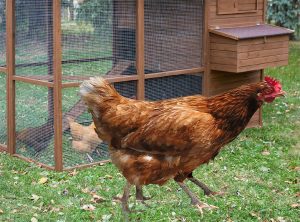 It has been the dream of poultry farmers for centuries but a team of British scientists has successfully edited the genomes of a hen’s egg to produce the world’s first four-legged bird. The ratio of leg meat yield to bird footprint is believed to be almost 1.8 times that of a regular two-legged hen with the birds consuming only 15% more feed.
It has been the dream of poultry farmers for centuries but a team of British scientists has successfully edited the genomes of a hen’s egg to produce the world’s first four-legged bird. The ratio of leg meat yield to bird footprint is believed to be almost 1.8 times that of a regular two-legged hen with the birds consuming only 15% more feed.
Hatched in April, the creature (named ‘Quadrietta’ by the scientists) is said to be fit and healthy and running around the secure enclosure at St. Olafs Avian Research Centre near Grantchester. Our Science Correspondent Dr Crispin Theodore Grundwald met the woman leading the project, Professor Emelia Flappe.
“It has been a long, hard struggle,” she said, “with quite a few false starts along the way. We have had chickens with one leg which kept falling over and last year, finally, a bird with a third leg, but that just looked silly.” Crispin asked if there had been any problems. “Not really, apart from catching her, the little devil. She’s as fast as a greyhound.”
Crispin asked Professor Flappe if she could explain, in layman’s terms for Spoofflé readers, the process they had used.
“Of course,” she said. “It was actually very straightforward. As everyone knows, Cas9 nuclease creates double-strand breaks in DNA at a site specified by a 20nt guide RNA (gRNA). so we simply resolved the double-strand break by homology-directed repair (HDR).”
Pressed on the possibility of a nomination for a Nobel prize and on which ways her team would now use the breakthrough to ease starvation in third world countries and benefit mankind, the professor was emphatic. “Oh good god no, we’ve sold the patent to KFC. I’m retiring.”
